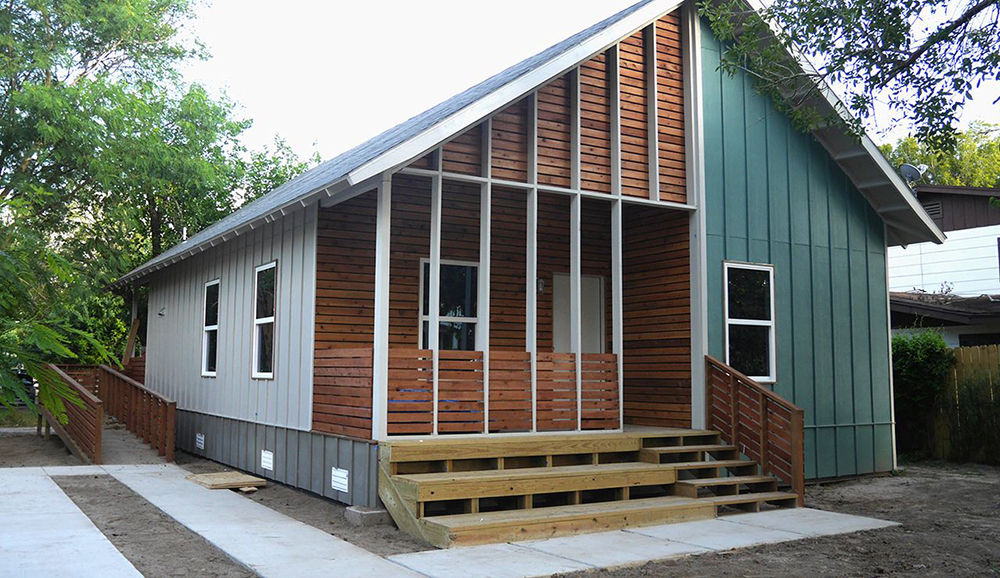The RAPIDO programme lets families move into a pre-assembled module
erected on their property before constructing their new home.
Scientists have developed a way to rebuild homes destroyed by natural disasters within a few months, an advance that may especially benefit low-income residents in disaster-prone areas.
RAPIDO, a pilot programme developed with recommendations from Texas A&M University's Hazard Reduction and Recovery Centre (HRRC), dramatically reduces the time it takes to rebuild homes destroyed by natural disasters.
Once accepted into the RAPIDO programme, families move into pre-assembled modules erected on their property within days of a disaster.
Then, the homeowners provide design input for their new homes, which are constructed around the module at a pace and budget they can afford.
The process creates a much quicker and more equitable path to permanent housing for low-income residents, who are often most at risk from disasters, researchers said.

A home built with input from Texas A&M researchers.
The Texas Senate Committee on Intergovernmental Relations is studying RAPIDO and other disaster recovery efforts in Texas to develop policy recommendations.
In a Texas Senate hearing on post-disaster housing recovery held last year, a San Benito resident, Amita Melendez, said that her mother, who had tried for years to rebuild her home that was badly damaged by Hurricane Dolly in 2008, was able to move into a modern, customised home within six months of entering the RAPIDO programme.
The programme is managed by a nonprofit organisation - founded by former Texas A&M student Brent Brown - that employs design to improve community livability and viability.
In developing recommendations for RAPIDO, researchers reviewed 40 reports detailing obstacles and challenges faced by homeowners trying to rebuild in the wake of Gulf and Atlantic coast hurricanes between 2005-2015.
"One key finding was the need to address long delays faced by those transitioning from temporary housing to permanent housing," said Shannon Van Zandt, from HRRC.
"The RAPIDO programme was developed to respond to this challenge by helping residents return to their property within three months, then build their home incrementally," said Van Zandt.
http://www.dnaindia.com/scitech/report-new-technique-to-quickly-rebuild-homes-destroyed-by-natural-disasters-2247642
Scientists have developed a way to rebuild homes destroyed by natural disasters within a few months, an advance that may especially benefit low-income residents in disaster-prone areas.
RAPIDO, a pilot programme developed with recommendations from Texas A&M University's Hazard Reduction and Recovery Centre (HRRC), dramatically reduces the time it takes to rebuild homes destroyed by natural disasters.
Once accepted into the RAPIDO programme, families move into pre-assembled modules erected on their property within days of a disaster.
Then, the homeowners provide design input for their new homes, which are constructed around the module at a pace and budget they can afford.
The process creates a much quicker and more equitable path to permanent housing for low-income residents, who are often most at risk from disasters, researchers said.

A home built with input from Texas A&M researchers.
The Texas Senate Committee on Intergovernmental Relations is studying RAPIDO and other disaster recovery efforts in Texas to develop policy recommendations.
In a Texas Senate hearing on post-disaster housing recovery held last year, a San Benito resident, Amita Melendez, said that her mother, who had tried for years to rebuild her home that was badly damaged by Hurricane Dolly in 2008, was able to move into a modern, customised home within six months of entering the RAPIDO programme.
The programme is managed by a nonprofit organisation - founded by former Texas A&M student Brent Brown - that employs design to improve community livability and viability.
In developing recommendations for RAPIDO, researchers reviewed 40 reports detailing obstacles and challenges faced by homeowners trying to rebuild in the wake of Gulf and Atlantic coast hurricanes between 2005-2015.
"One key finding was the need to address long delays faced by those transitioning from temporary housing to permanent housing," said Shannon Van Zandt, from HRRC.
"The RAPIDO programme was developed to respond to this challenge by helping residents return to their property within three months, then build their home incrementally," said Van Zandt.
http://www.dnaindia.com/scitech/report-new-technique-to-quickly-rebuild-homes-destroyed-by-natural-disasters-2247642

No comments :
Post a Comment